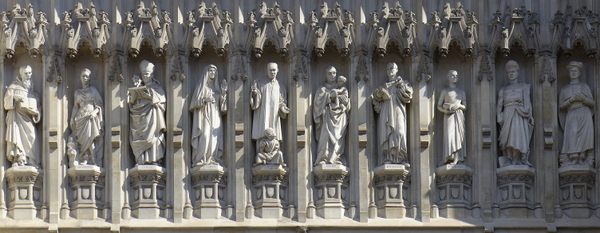Many of the largest medieval churches across Europe feature façades decorated with statues and other representations of individuals from Christianity, including saints and other biblical figures, but these individuals typically lived centuries ago. Even though their stories are still important to modern Christianity, the lives and experiences of these individuals are set in times beyond living memory. This makes the Modern Martyrs display above the western entrance to Westminster Abbey unique among churches across Europe.
Westminster Abbey itself was largely constructed in the thirteenth century, although many modifications have been made over the centuries. The façade over the western entrance was completed in the fifteenth century with a set of ten niches for statues. However, the niches were never actually filled.
During restoration works in 1995, the church initiated a plan to fill the niches with a set of statues representing Christian individuals from the twentieth century. A committee selected ten individuals of various nationalities from various Christian denominations. All of these people would be martyrs who gave their lives for the sake of others or for the sake of Christianity. The creation of the statues was guided by the sculptor Tim Crawley, and the statues were unveiled to the public in 1998 by the Archbishop of Canterbury.
These statues were named the Modern Martyrs. Some of the depicted people are quite famous, while others may be much more obscure. The most famous individual is Dr. Martin Luther King Jr., who notably led the civil rights movement in the United States in the 1950s and 1960s. The next most famous individual may be St. Oscar Romero, an advocate for the poor who was assassinated at the start of the Salvadorean Civil War. The other saint represented among the statues is St. Maximilian Kolbe, who died in the Auschwitz Concentration Camp during World War II.
Most of the other individuals represented among the Modern Martyrs were caught up in some of the most notable events of the twentieth century and would die because of their Christian faith. Dietrich Bonhoeffer was a Polish priest who was also executed by Nazis during World War II, while Lucien Tapedi was a missionary in Papua New Guinea who was killed by the Japanese Army during the same war. Grand Duchess Elizabeth was a Russian nun executed during the Russian Revolution, Chinese pastor Wang Zhiming was killed during the Chinese Cultural Revolution, and Ugandan archbishop Janani Luwum was murdered for opposing the brutal dictatorship of Idi Amin.
The remaining two individuals among the Modern Martyrs were not people associated in any larger conflict or event but were simply people of great faith who were killed for their Christian beliefs. Esther John evangelized across Pakistan during the 1950s but was found murdered in her bed in 1960. Manche Masemola was just a teenage South African girl with a deep faith in Christianity who was murdered by her parents because of her beliefs; the place where she was buried has since become a major pilgrimage site.
Collected together, these ten individuals show that the persecution of Christians is not a thing of the distant past but something that has persisted in modern times. The Modern Martyrs also makes deep comments about how these individuals’ faith and desire to improve the world will still be remembered after the most violent events of the twentieth century.

